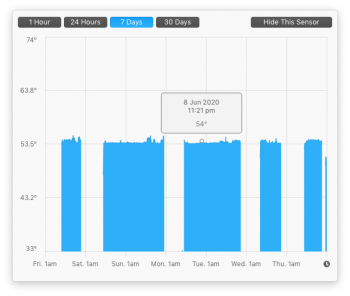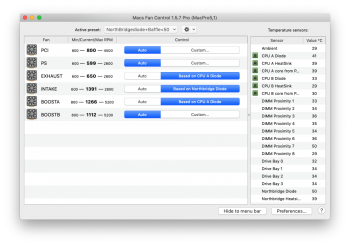@h9826790 Yes that is indeed a great idea.
I've also been thinking of a way to get more air over the NB Heatsink. I was just brute forcing the problem for a few days with a Macs Fan Control driven brute force attempt at pushing more air through the A CPU ( at rear of the Mac ). I'm just generally unhappy with this approach.
Why?
1. Using the CPU A Boost fan method from my previous post was getting on my nerves as the small fan inside the Heatsink was running at mid speed give a great mosquito pitched whine.
2. moving back to "auto" settings and therefore without the whine the Northbridge temperatures were just too high in mid 60ºC for my comfort and despite ignoring my Northbridge for 5 years I'd like to not have the processor board fail from inaction.
So to Action!
Get McGuyver prototype, what ever was handy and could be interated before dinner was due on the table ( my turn to cook ).
Prototype
Here's my 15 minute prototype in A4 80 GSM A4 and Cello tape. which I left installed and running under test while cooking pasta bolognese from a frozen base sauce with fresh everything else.
ta da' THE Mac Pro Air Baffle ( origami edition ) is born.
View attachment 919346View attachment 919347View attachment 919348
MacsFan settings
Back story: I've spent a bit of research time from my olden days at IBM. we introduced a Racked server "back in the day" and it had an innovative Air baffle as part of a memory and CPU up-scalable feature that allowed some similar scaling as the cMP ( Classic Mac Pro series ). There was one part in particular that I was enamored with. 'The Air Baffle', IT was both a gift and a impediment to servicing and adding RAM but if left out it was well known by field engineers to be a required part to avoid auto shutdown conditions.
Therefore I posit that while Apple's very capable engineers configured the processor board for a laminar flow they did not win the marketing / design battle to add a air flow guide ( baffle) to direct air over the North Bridge Heatsink Fins.
Bear in mind that IBM x346 had a similar power density but with 16 redundant fans and no effective sound output limits. X346 26.44 litres with 2 x 650 Watt Power Supplies giving 51 Watts per litre versus Mac Pro 5,1 with 43 litres and 980 Watts 22.8 Watts per litre or less than half the density. No criticism intended but there are therefore weaker spots in the design, aka the NB thermal problem!
What did IBM do ?
View attachment 919344
Testing
Initial testing Using iCore System Load running full load on 2 x 6 Cores of x5680 with 8 x 4 GB RAM slots 1-8 Full.
It seems the Inlet fan can provide sufficient total pressure to keep the velocity high enough to actually reduce the Northbridge temp check the attached 45 minute Full load test graph captured using Hardware Monitor.
View attachment 919349
Next Steps
Given the Hypothesis seems supported by the experiment I will now try fabricating a fit test model on my hobby 3d PLA Printer, It wil take some more time to get a heat resistant version.
Time Frame
Possibly 3 weeks for an testable engineering prototype.
If your'e interested just pop a reply.



